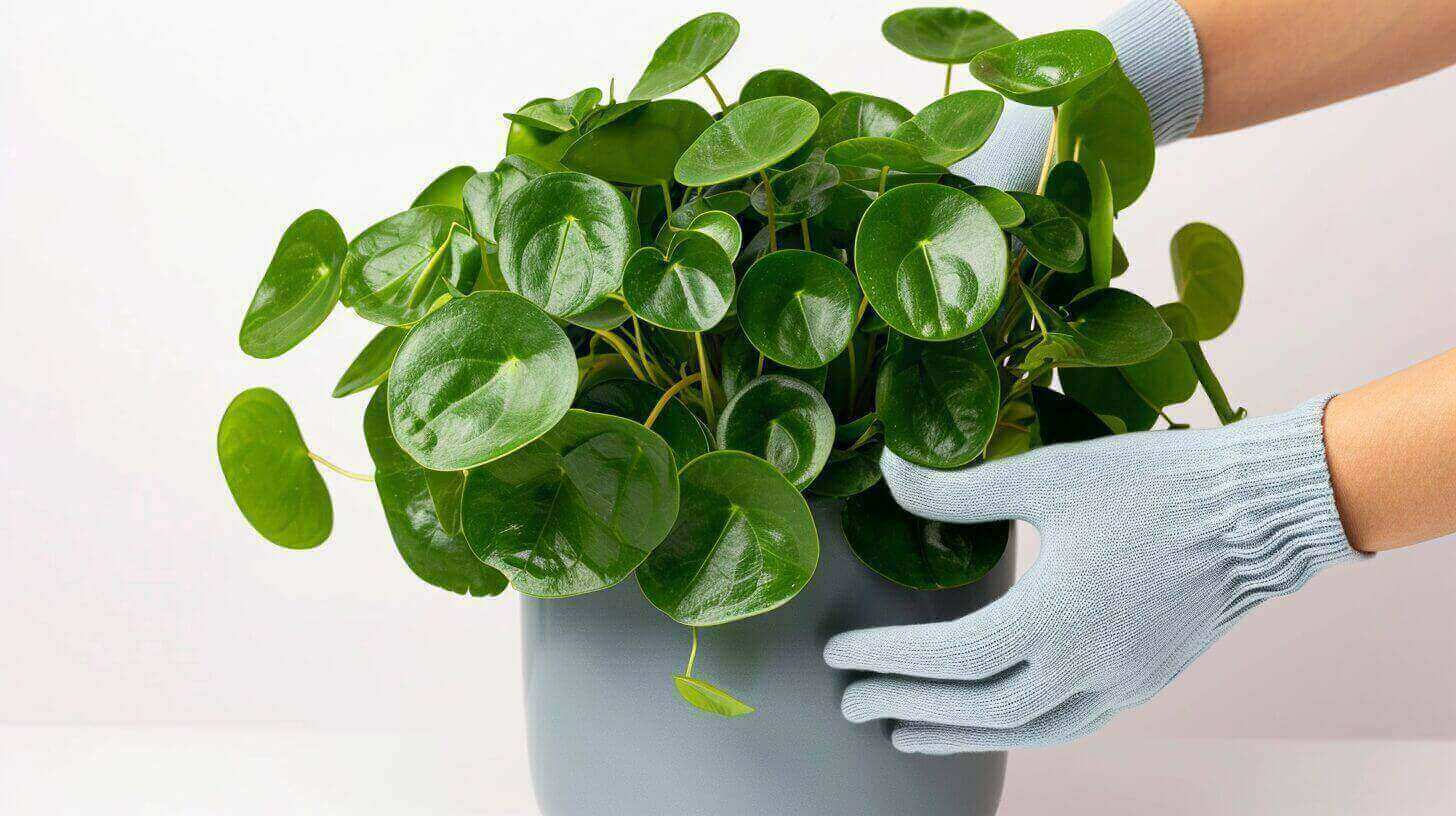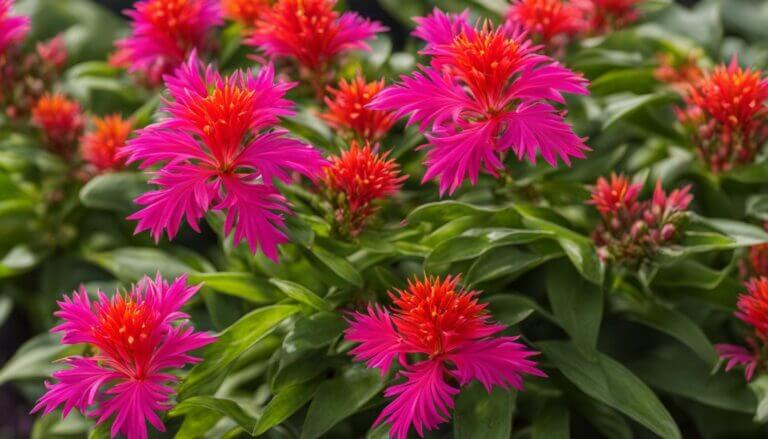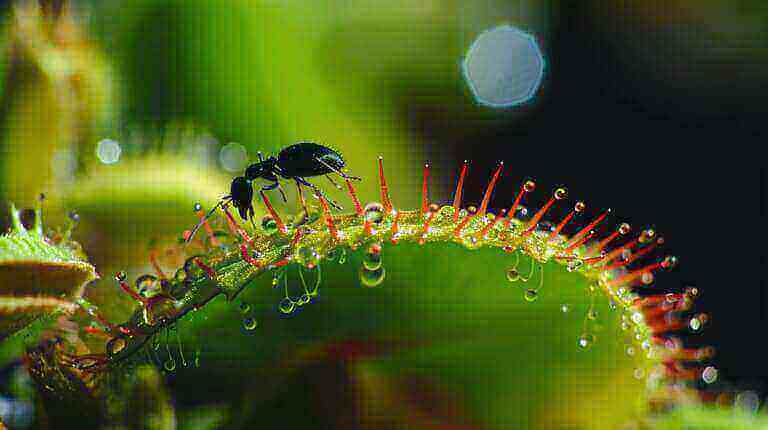How to Care for a Pilea Peperomioides or Chinese Money Plant Indoors
The Pilea Peperomioides, also known as the Chinese Money Plant, UFO plant, and pancake plant, is an easy-to-care-for houseplant. Native to southern China, this plant has become popular worldwide due to its low-maintenance nature. It has round, coin-shaped leaves that overlap, giving it a unique stacked coin appearance. To care for a Pilea Peperomioides or Chinese Money Plant indoors, you need to ensure proper watering, provide adequate light, and occasionally rotate the plant for even growth.
These pilea plants can tolerate temperatures above 10°C but should be kept away from direct sunlight to avoid leaf burn. Regularly dusting the leaves with a cloth will help keep them clean and healthy. Fertilize the plant every few months during the growing season to promote optimal growth.
Key Takeaways:
- Proper watering is essential for the health of a Pilea Peperomioides or Chinese Money Plant. Water when the top inch of soil feels dry to the touch.
- Provide bright, indirect light for your plant by placing it near a window. Use sheer curtains to filter the light and prevent leaf burn.
- Repot your Pilea Peperomioides every two years using well-draining potting soil and a pot with drainage holes.
- Maintain average room humidity to prevent leaf crisping and burning. Use a tray of water or a humidifier to increase humidity if needed.
- Monitor your plant for common issues such as brown or crispy leaves, droopy leaves, or yellowing stems. Take appropriate measures to address these problems.
Watering Tips for a Pilea Peperomioides or Chinese Money Plant
Proper watering is essential for the health and well-being of your Pilea Peperomioides or Chinese Money Plant. Here are some tips to help you water your plant effectively:
- Check the soil: Before watering, always check the top inch of soil. If it feels dry to the touch, it’s time to water your plant.
- Watering frequency: In general, Pilea Peperomioides plants need watering once a week during the summer months when they are actively growing. In winter, you can reduce the frequency to once every two weeks. Adjust the watering schedule based on the moisture level of the soil.
- Avoid overwatering: Overwatering can lead to root rot and other issues. It’s crucial to allow the soil to dry out slightly between waterings. Make sure not to let the soil become bone dry, as this can also harm the plant.
- Drainage is key: Ensure that the pot has proper drainage holes to allow excess water to escape. Empty any water that collects in the drainage tray to prevent the plant from sitting in standing water.
Table: Watering Guidelines for a Pilea Peperomioides or Chinese Money Plant
| Season | Watering Frequency | |
|---|---|---|
| Summer | Once a week | |
| Winter | Once every two weeks |
Providing the Right Light Conditions for Your Pilea Peperomioides or Chinese Money Plant
The Pilea Peperomioides, also known as the Chinese Money Plant, requires specific light conditions to thrive indoors. Providing the right amount and type of light will promote healthy growth and keep your plant looking its best.
Chinese Money Plants prefer bright, indirect light. Placing them near a window where they can receive plenty of gentle, filtered sunlight is ideal. Avoid direct sunlight, as it can burn the leaves and cause damage to the plant. If you notice that your plant is leaning towards the light source, it’s a sign that it’s not receiving enough light. Rotate the plant every few days to ensure even growth.
If you don’t have access to sufficient natural light, you can use grow lights to supplement the light requirements of your Pilea Peperomioides. There are various types of grow lights available, including fluorescent and LED options. Choose a light that emits a spectrum similar to natural sunlight, and position it at an appropriate distance from the plant to provide adequate light intensity.
| Light Requirements for Pilea Peperomioides | Chinese Money Plant Light Conditions |
|---|---|
| Bright, indirect light | Place near a window or use grow lights |
| Avoid direct sunlight | Rotate the plant for even growth |
Repotting and Propagation Tips for a Pilea Plant or Chinese Money Plant
Proper repotting and propagation techniques are essential for the healthy growth of a Pilea Peperomioides or Chinese Money Plant. Repotting is typically done every two years to ensure the plant has enough space to grow. Choose a pot that has drainage holes to prevent waterlogging and use well-draining potting soil to promote healthy root development.
When repotting, gently remove the plant from its current pot and inspect the roots. Trim any damaged or diseased roots with clean scissors or shears. Place the plant in the new pot, making sure it sits at the same depth it was previously planted. Fill the pot with fresh soil, firming it gently around the plant to provide stability. Water the plant thoroughly after repotting to help settle the soil.
Propagation of a Pilea Peperomioides or Chinese Money Plant can be done through stem cuttings or propagation of its baby plants, known as “pups.” To propagate through stem cuttings, take a healthy stem with several leaves and remove the lower leaves. Place the cutting in a glass of water or in moist soil until new roots form. Once the roots are established, you can transfer the cutting to a new pot.
Another propagation method is allowing the plant to produce pups. These are small plants that form at the base of the mother plant or along the stems. Carefully separate the pups from the mother plant, ensuring each has some roots attached. Plant the pups in their own pots with well-draining soil and provide them with the same care as the adult plant. Propagation is an excellent way to expand your collection of Pilea Peperomioides or Chinese Money Plants while sharing their beauty with others.
Table: Comparison of Repotting and Propagation Methods for Pilea Peperomioides or Chinese Money Plants
| Method | Pros | Cons |
|---|---|---|
| Repotting | – Provides the plant with fresh nutrients – Allows for root inspection and pruning – Prevents root-bound growth | – Can be stressful for the plant – Requires careful handling to avoid root damage |
| Stem Cuttings | – Easily creates new plants – Faster method of propagation – Higher success rate | – Requires patience as new roots form – Cuttings may take time to establish in soil |
| Pup Propagation | – Allows for multiple new plants from a single mother plant – Plants start with established roots | – Pups may take longer to grow than stem cuttings – Requires careful separation from the mother plant |
Maintaining Humidity and Temperature for a Pilea Peperomiodes or Chinese Money Plant
Proper humidity and temperature levels are essential for the well-being of your Pilea Peperomioides or Chinese Money Plant. These factors play a significant role in the plant’s growth, health, and overall vitality. In this section, I will discuss the importance of maintaining adequate humidity and temperature and provide practical tips to ensure optimal conditions for your indoor plants.
Indoor plants, including Pilea Peperomioides, thrive in environments with average room humidity. The ideal humidity range for these plants is between 40% and 60%. If the humidity levels drop below this range, the edges of the plant’s leaves may start to crisp or burn. To increase humidity, you can place a tray of water near the plant or use a humidifier. This will help create a more favorable environment for your Pilea Peperomioides to thrive.
When it comes to temperature, Pilea Peperomioides prefers a consistent range between 18°C and 24°C. These plants are sensitive to extreme temperature fluctuations, so it’s essential to keep them away from windows, doors, and drafts. Rapid changes in temperature can stress the plant and lead to leaf yellowing or wilted growth. Maintaining a stable temperature within the recommended range will promote healthy growth and prevent unnecessary stress on your Pilea Peperomioides.
The importance of humidity and temperature for Pilea Peperomioides:
- Optimal humidity levels (40-60%) prevent leaf crisping or burning.
- Consistent temperature range (18-24°C) ensures healthy growth without stress.
Tips for maintaining humidity and temperature:
- Place a tray of water near the plant to increase humidity.
- Use a humidifier to create a more favorable environment for your plant.
- Avoid exposing your Pilea Peperomioides to direct drafts or extreme temperature fluctuations.
- Monitor the humidity and temperature levels regularly to ensure they remain within the recommended ranges.
By providing the right humidity and temperature conditions for your Pilea Peperomioides or Chinese Money Plant, you can create an environment that promotes healthy growth and thriving foliage. Remember to monitor these factors regularly and make adjustments as needed to ensure the well-being of your indoor plants.
Common Issues and Troubleshooting for a Pilea Peperomioides or Chinese Money Plant
While the Pilea Peperomioides or Chinese Money Plant is generally easy to care for, it can still encounter common issues. By being aware of these problems and knowing how to troubleshoot them, you can ensure the health and longevity of your plant.
Pilea Peperomioides Common Problems
One common issue with Pilea Peperomioides is brown and crispy leaves. This is often a result of underwatering or low humidity. To remedy this, make sure you are watering your plant adequately and consider increasing the humidity by placing a tray of water nearby or using a humidifier.
Droopy leaves are another problem that can occur when the plant is underwatered. If you notice your Pilea’s leaves looking wilted or limp, it’s a sign that it needs more water. Adjust your watering schedule accordingly, ensuring the soil doesn’t become bone dry between waterings.
Yellowing or black stems are indications of overwatering and root rot. To prevent this issue, be careful not to overwater your plant and ensure proper drainage. If you notice any signs of root rot, trim away the affected areas and repot the plant in fresh, well-draining soil.
Chinese Money Plant Troubleshooting
In addition to the common problems mentioned above, Chinese Money Plants can also experience domed or curved leaves when they don’t receive enough light. If you notice your plant leaning towards the light source or its leaves appearing deformed, it’s a sign that it needs more light. Adjust the placement of your plant to ensure it receives bright, indirect light or consider using grow lights to supplement the lighting conditions.
Regularly inspect your plant for any signs of pests, such as white spots on the leaves, which may indicate a spider mite infestation. If pests are present, isolate the affected plant and treat it with an appropriate insecticide or natural pest control method. Taking prompt action can prevent further damage to your plant and help it recover.
By addressing these common issues promptly and providing your Pilea Peperomioides or Chinese Money Plant with the proper care, you can enjoy a thriving and beautiful plant in your indoor space.
Fertilizing and Caring for a Pilea Peperomioides or Chinese Money Plant
When it comes to caring for your Pilea Peperomioides or Chinese Money Plant, proper fertilizing is essential. To keep your plant healthy and thriving, fertilize it every few months during the growing season, which typically spans from spring to summer. Use a balanced houseplant fertilizer and follow the instructions on the packaging for application and dosage.
In addition to fertilizing, regular dusting of the plant’s leaves is important. Dust particles can hinder the plant’s ability to photosynthesize, so gently wipe the leaves with a cloth to keep them clean and free of dust. This simple act will help promote optimal growth and overall plant health.
Remember to monitor the growth of your Pilea Peperomioides or Chinese Money Plant and adjust your care routine accordingly. Rotate the plant every few days to ensure even growth, and periodically check the moisture of the soil to ensure you are providing the right amount of water. By giving your plant the proper care it needs, you can enjoy its beauty and lush foliage in your indoor space.
FAQ
How do I propagate a Chinese Money Plant?
Propagating a Chinese Money Plant is easy. Look for baby plants that grow from the base of the mother plant. You can gently remove these and pot them in a pot with a drainage hole. Make sure to keep the new plant in indirect light as direct sunlight can cause the leaves to turn yellow.
How do I care for my Pilea indoors?
As an indoor plant, Pilea prefers bright, indirect light. It can adapt to lower light conditions, but the leaves may not be as vibrant. Rotate the plant every few days to ensure all sides receive light. Keep the plant away from drafts and sudden temperature changes.
How easy is it to care for a Chinese Money Plant?
The Chinese Money Plant is known for its ease of care. It’s an easy plant to take care of, making it a popular choice among plant enthusiasts. With proper light, water, and care, this plant can be a beautiful addition to any indoor plant collection.







